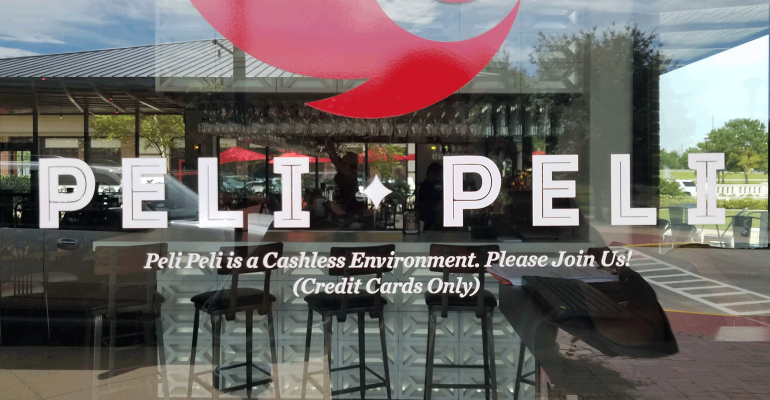Credit and debit cards have been America’s preferred methods of payment for years. But recently, mobile payments and credit card perks have boosted cashless spending even more.
According to the 2016 U.S. Consumer Payment Study, conducted by TSYS, 40 percent of Americans prefer to pay with credit, 35 percent opt for debit and 11 percent choose to pay with cash. When broken down by age and income, 5 percent of those between 25 and 34 years old use cash. And 99 percent of consumers with a household income over $100,000 use credit or debit for purchases.
The cashless trend is quickly spilling over into the restaurant industry, with some operators eschewing cash altogether.
“We were motivated to go cashless by Uber, which digitizes everything,” said Thomas Nguyen, co-founder of five-unit, Houston-based Peli Peli Restaurant Group, which runs two of its fast-casual locations and a fine-dining restaurant cashless.
Peli Peli alerts guests via a sign on the door and at its main payment station that cash is not accepted at the restaurants.
“Once we explain the cons of cash to our customers, such as how dirty it is and how much faster the order line can move without it, they usually understand the motivation behind going cashless,” Nguyen said.
The restaurant Sunday in Brooklyn, located in Brooklyn, N.Y., has been cash free since it opened last year. Speed was the reasoning behind the decision.
“We always try to find ways to make our team more efficient and focus their time on important things like taking care of our guest,” said partner Adam Landsman.
Ultimately, it’s simply faster to swipe a card, and the restaurant does so tableside.
“The bartenders don't stay hours after their shift trying to reconcile their banks. The same goes for the managers and our accountant,” he said.
Nguyen agreed that restaurants spend an enormous amount of time counting cash, and noted that safety is also a concern.
“It’s not safe to hold that much cash in the restaurant or have to transport it to the bank each day,” Nguyen said. “Being cashless is safer for everyone, and it also minimizes the incidence of employee theft.”
Landsman noted that most customers prefer to pay with a card anyway.
“The business pays more in credit card fees, but the time saved by using the credit cards is worth more,” he said.
The cleanliness, safety and support benefits come along with running a cash-free operation, Landsman pointed out.
“Cash is very dirty, and we handle food,” he said. “We also eliminate the worry over carrying cash tips home late and the potential loss of money throughout the day. Plus, if there’s ever an issue with a check the next day, it's easy to see what happened and correct it quickly.”
Nguyen also expressed concerns over handling money in an environment that serves food.
“Cash has been handled by thousands of people,” he said. “No one really thinks about how dirty it is to have money around our food.”
While nearly 90 percent of consumers have made the switch to plastic, there are still some customers who prefer to pay in cash.
“International guests can sometimes be charged more to pay with a credit card. If this happens, we let guests know, and one of us will put the bill on our personal card and let them pay in cash, so they don't have to worry about it,” Landsman said.
Nguyen said not everyone is ready to transition to cashless, so Peli Peli has a backup company credit card if a customer can’t pay with a card.
“It’s part of growing pains when you’re trying something new,” he said. “I imagine we’ll deal with that a few more times until people get used to it.”




